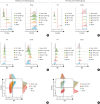Therapeutic Efficacy of YH35324 on FcεRIα-Mediated Mast Cell/Basophil Activation
- PMID: 40204504
- PMCID: PMC11982638
- DOI: 10.4168/aair.2025.17.2.181
Therapeutic Efficacy of YH35324 on FcεRIα-Mediated Mast Cell/Basophil Activation
Abstract
Purpose: Immunoglobulin E (IgE) induces mast cell/basophil activation by binding with FcεRIα and contributes to the development of allergic disease, in which targeting IgE has been considered an effective therapeutic strategy. YH35324 (YH) is a new hybrid protein with an extracellular domain consisting of FcεRIα, and its pharmacodynamic effect and safety were validated. This study aimed to evaluate the therapeutic potential of YH as an anti-IgE immunomodulator compared with omalizumab (Oma).
Methods: To evaluate the in vitro efficacy of YH in human mast cells, YH was treated with various methods, and the changes were confirmed through flow cytometry, immunoblot analysis, and immunocytochemistry. To evaluate the ex vivo efficacy of YH, the expression of FcεRIα on the surface of blood basophils was measured in 64 subjects with allergic diseases by flow cytometry. Serum soluble FcεRIα, CD23, and Mas-Related G-Protein Coupled Receptor Member X2 levels were measured by enzyme-linked immunosorbent assay.
Results: The YH-administered group exhibited significantly lower expression of FcεRIα on peripheral basophils compared to the Oma-administered group up to 14 days post-administration. YH directly suppressed FcεRIα expression on the surface of LAD2 cells, as it was bound to IgE-unbound FcεRIα and migrated into the cells by actin-dependent endocytosis, then was recycled by FcRn binding in the lysosome in vitro. Serum soluble FcεRIα levels were increased in the YH-administered group compared to the other groups and showed a positive correlation with serum-free IgE.
Conclusions: YH represents a new therapeutic agent for IgE-mediated allergic disease. Further studies are needed to evaluate its additional effects on the FcεRIα-mediated autoimmune mechanism.
Keywords: Fc epsilon RI; IgE; allergy; anti-IgE antibodies; basophil; mast cell; urticaria.
Copyright © 2025 The Korean Academy of Asthma, Allergy and Clinical Immunology • The Korean Academy of Pediatric Allergy and Respiratory Disease.
Conflict of interest statement
Kim J, Lee SY are employees of the Yuhan Corporation. All authors declare no competing financial and non-financial interests.
Figures







